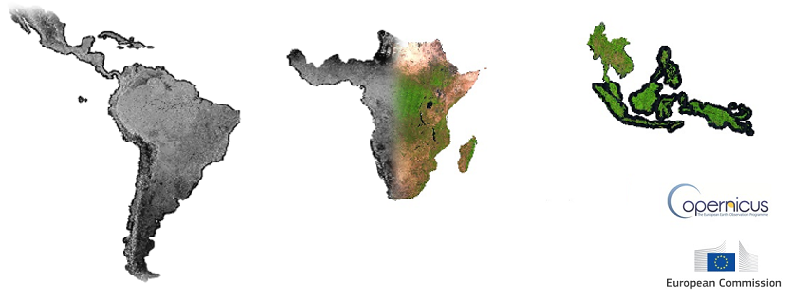
The ensemble of the first two Sentinel sensor platforms constitutes a unique European monitoring capacity for land surface characterization that can be applied globally and
consistently to forestry applications. While technical superior to any other current monitoring capacity, the interoperability with the US Landsat 8 and possible other sensors
that may provide high resolution imagery under “free and open” licenses, will further increase essential data availability.
The recent availability of time series of imagery from the Sentinel satellites represents a significant technological step in the use of Earth Observation (EO) data for
forest cover monitoring. The 5 days revisiting time of the Sentinel-2 platform (S-2 A and S-2B satellites) and the 10 m spatial resolution of the Sentinel-2 optical imagery
imply the need for much larger storage and processing resources than ever.
Besides optical data from Sentinel-2, also radar (SAR) data from Sentinel-1 platforms is needed systematically as additional information layer and for areas with persistent
cloud cover (see for example Verhegghen et al. 2016 [4] ).
To facilitate the use of Sentinel’s imagery by national forestry services in the tropics (in particular in relation to REDD+ activities), the JRC has developed:
- Sentinel-2 web platform for REDD+ monitoring: an online Web system which is aimed at browsing, exploring and processing the full dataset of Sentinel-2 imagery available over the Tropical belt
- Sentinel-2 pan tropical composite: cloud free image mosaic at 20m resolution covering the full tropical belt, produced by processing all available Sentinel-2 data (2A and 2B from Oct.2015 to Oct.2017 and entire 2018).
- Sentinel-1 pan tropical composite: backscatter radar mosaic composite at 20m resolution covering the full tropical belt produced by processing all available Sentinel 1 data (1A and 1B from October 2016 to October 2017) with VV and VH polarizations.
Processing of Sentinel-2 and Sentinel-1 composite has been performed in the
Google Earth Engine platform [5].
Background reading and web sites:
Technical References
[2] Simonetti D., Marelli A., Rodriguez D., Veselin V., Strobl P., Burger A., Soille P., Achard F., Eva H., Stibig H.J., Beuchle R.
, 2017
Sentinel-2 web platform for REDD+ monitoring,online web platform for browsing and processing Sentinel-2 data for forest cover monitoring over the Tropics.
Luxembourg: Publications Office of the European Union, EUR28658; doi:10.2760/790249
https://ec.europa.eu/jrc/en/publication/sentinel-2-web-platform-redd-monitoring-online-web-platform-browsing-and-processing-sentinel-2-data
[4] Verhegghen A., Eva H.D., Ceccherini G., Achard F., Gond V., Gourlet S., Cerutti P.O.
, 2016
The Potential of Sentinel Satellites for Burnt Area Mapping and Monitoring in the Congo Basin Forests
Remote Sensing 2016, 8, 986; doi:10.3390/rs8120986
https://www.mdpi.com/2072-4292/8/12/986/
[5] Gorelick N., Hancher M., Dixon M., Ilyushchenko S., Thau D., Moore R.
, 2017
Google Earth Engine: Planetary-scale geospatial analysis for everyone
Remote Sensing of Environment, ISSN 0034-4257
https://doi.org/10.1016/j.rse.2017.06.031
